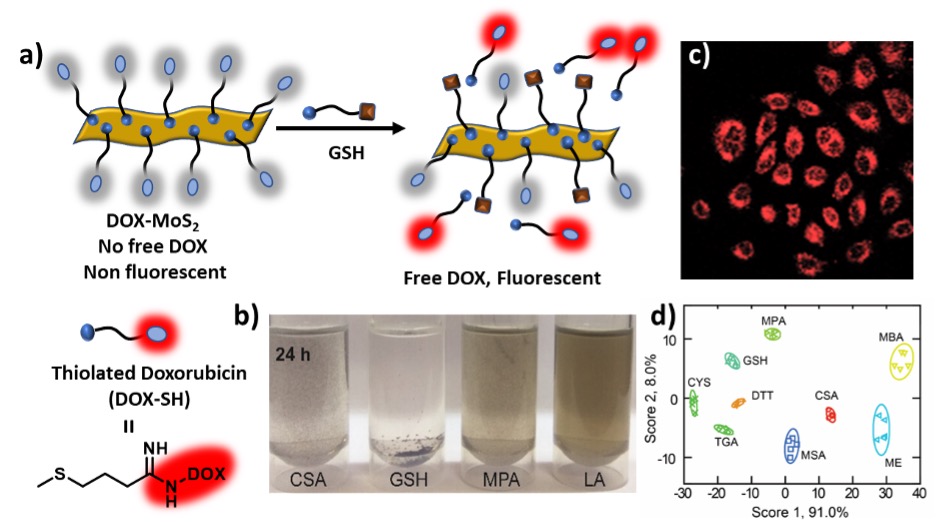02 March 2023
–Gowri R
In a recent study, researchers from the Department of Organic Chemistry (OC) and Materials Research Centre (MRC), Indian Institute of Science (IISc), show that surface modifications of two-dimensional molybdenum disulphide (2D-MoS2) nanosheets can make them highly effective for applications like delivering drugs to diseased cells.
Nanomaterials usually need to be modified or customised depending on the application to improve their efficiency. Typically, they are chemically modified through a process called functionalisation, which involves attaching ligands (small or large molecules) to the surface of the nanomaterial.
In the new study, the researchers modified the surface of 2D-MoS2 nanosheets with thiol (sulphur-containing) ligands. They found that these thiols can be exchanged with naturally-occurring thiols in biological systems, which could allow drugs attached to these nanosheets to be released. These chemically-modified nanosheets were also found to be safe to use inside living cells.

a) Schematic representation of thiol exchange scheme which shows the fluorescence DOX released in presence of Glutathione (GSH) molecule. b) Selectivity of thiol exchange with thiols compared to disulphides. Precipitation was clearly observed for thiols like Cysteamine (CSA), Glutathione (GSH), Mercaptopropionic acid (MPA). However Lipoic acid (LA), a disulphide shows no precipitation which indicate no significant thiol exchange. c) Release of fluorescent DOX in cancer cells confirmed through confocal imaging. d) Canonical score plot for successful discrimination of various bio-thiols.
“Our study shows that thiol exchange on 2D-MoS2 nanosheets is effective, and the nanomaterial is stable in the presence of various biomolecules. This is an important observation as it will make this nanomaterial highly beneficial for biomedical applications like drug delivery,” explains Mrinmoy De, Associate Professor at the Department of Organic Chemistry and senior author of the study published in ACS Nano.
The team first used a fluorescent thiol called boron-dipyrromethene (BOD-SH) to modify the surface of the 2D-MoS2 nanosheets in order to create a functionalised version (BOD-MoS2). Then, they tested the possibility of thiol-to-thiol exchange on BOD-MoS2 using glutathione (GSH) – a naturally occurring thiol found in abundance in cancer cells. They found that GSH molecules swapped places with BOD-SH on the surface of the nanosheet – a process that they confirmed using fluorescence techniques.
When the researchers attached an anti-cancer drug named doxorubicin (DOX) to the nanosheet surface, they found that thiol exchange could also happen between GSH and DOX, allowing DOX to get dropped off at the diseased site. Because the exchange happens only in the presence of high concentrations of GSH found in diseased cells, drugs like DOX can be delivered specifically to cancer cells without affecting normal cells, which can also potentially reduce any side effects.
Previous efforts have focused on using gold nanoparticles for such biomedical applications, according to the researchers, but these nanoparticles are expensive and have limited efficiency due to their non-selectivity between mono thiols and disulphides. “Our experiments show that 2D-MoS2 nanosheets can be an effective substitute for gold nanoparticles, and they will be greatly beneficial in the field of nanomedicine,” says Pradipta Behera, a postdoctoral research scholar at IISc and the first author of the study. The MoS2 nanosheets were found to be stable in the presence of biofluids. They also have a higher surface area than gold nanoparticles, which means that they can be more efficient.
Moving forward, the team plans to work on improving the stability of the nanomaterial in the presence of various thiol-containing liquids and exploring alternative surface modification approaches to customise the nanosheets for other applications. “This work on 2D-MoS2 nanosheets can be developed in the future as an alternative to RNA and DNA delivery applications, which can be useful for detecting and treating infections such as COVID-19,” adds Behera.
REFERENCE:
Behera P, Karunakaran S, Sahoo J, Bhatt P, Rana S, & De M, Ligand Exchange on MoS2 Nanosheets: Applications in Array-Based Sensing and Drug Delivery, ACS Nano (2022).
https://pubs.acs.org/doi/10.1021/acsnano.2c06994
CONTACT:
Mrinmoy De
Associate Professor
Department of Organic Chemistry
Indian Institute of Science (IISc)
Email: md@iisc.ac.in
Phone: +91-80-2293-2042 (Office) / 2436 (Lab)
Website: https://orgchem.iisc.ac.in/mrinmoy_de/
Credit: Pradipta Behera
NOTE TO JOURNALISTS:
- a) If any of the text in this release is reproduced verbatim, please credit the IISc press release.
- b) For any queries about IISc press releases, please write tonews@iisc.ac.inor pro@iisc.ac.in.


